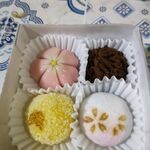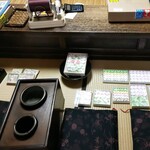
亀屋則克
Kameyanorikatsu ◆ かめやのりかつ
3.60
Imperial Palace Area
「Japanese Sweets」
--
--
Opening hours: 9:00-17:00
Rest time: Sundays, national holidays, and the third Wednesday of the month Business hours and holidays are subject to change, so please check with the store before visiting.
京都府京都市中京区堺町通三条上ル大阪材木町702
Photos
(20)




















Details
Comments
(18)
カフェモカ男
3.70
I visited "Kameya Norikatsu," a traditional Japanese confectionery store located in Kyoto city. Established in 1927, this shop is known for preserving the original flavors passed down through three generations. The access is convenient, just a 5-minute walk from Karasuma Oike Station on the Karasuma Line. Today, I tried some of their menu items:
- "Ryosui": A refreshing confectionery resembling a water gate by the riverside.
- "Hamashizuku": A limited-time seasonal sweet available from early May to mid-September. This elegant treat, shaped like a seashell, contains a single grain of miso-flavored "hamanatto" within amber-colored agar. It is beautifully packaged in a bamboo basket.
- "Kigi Tsuyu": An artistic Japanese sweet reminiscent of morning dew on the trees.
- "Hama Omiyage": A sparkling confectionery adorned with water droplets, exuding an elegant sweetness.
Overall, it was a delightful experience. Thank you for the meal.




joejoe101
4.00
Standing between buildings is a traditional house with a nostalgic storefront. Inside, there are samples of traditional Japanese sweets on display. You can choose from several types of fresh sweets, each costing around 500 yen. Options include regular black bean, coconut, yuzu, sakura mochi, and another with brown sugar. The spring-themed designs and flavors are fantastic. As you wait for your sweets to be boxed up, you can sit and enjoy the view inside the shop, which is filled with various wooden molds used in making the sweets.




karina-mama
3.50
I purchased traditional Japanese sweets for New Year's. The "Shibu" (real pine) is made from sweet potato and wrapped in thin dough with sweet bean paste inside. The "Neji Ume" is a peach-colored sweet bean paste with a glossy finish. The "Eto" is made from soft rice dough with a chewy texture. The "Hane Tai" is a firm and well-structured sweet made from red bean paste. The "Warabi Mochi" is made from carefully kneaded bracken flour with sweet bean paste. Each sweet has the perfect level of sweetness and is delicious. I regret not pairing them with strong tea. Each sweet is handmade with care, using traditional wooden molds. The sweets are sold in a rare sitting style shop, filled with the essence of Kyoto.


hardrive
3.40
I purchased the following 4 items: ① Souvenirs from the beach: Kinntama jelly, Hamanatto ② Fragrant Trees: Lemon syrup, Chestnut yokan ③ Summer Dew: Kinntama jelly ④ Kuzu-yaki: Yoshino Honkuzu ① is said to be the summer specialty of this shop. The Kinntama jelly is snugly placed inside a seashell. Due to the season, there are many yokan-like items overall. As I have mentioned several times, I am not particularly fond of Kinntama jelly, so the rating is slightly lower.

放蕩むすこ
4.20
Established in 1916 by Kameya Ryosoku, a branch of the renowned Kameya confectionery, Hama no Kaigara is a traditional Japanese sweets shop known for its unique confection. The treat consists of a clamshell made of amber-colored agar jelly filled with miso-flavored fermented soybeans. Designed to resemble a seaside souvenir, this dessert can last even in the heat of summer. Best served chilled, the sweet and savory flavors of the agar jelly and fermented soybeans harmonize to create a distinct taste. To enjoy, simply crack open the smooth shell and scoop out the filling. This dessert is a delightful and intriguing treat that has been passed down through generations.


ごろごろはっちゃん
3.40
A shop in Kyoto with a traditional "seat sale" style. My family went to Kyoto, and I requested them to buy some items for me. I wanted to try some warabi mochi, but unfortunately, they were already sold out at this time of year, along with other types of fresh sweets. I also pre-ordered the following two items for them to buy on the way:
- Kuzuyaki (Kuzu cake) - 400 yen
Made with Yoshino kudzu. Only available from May to September. The texture is fluffy and melts in your mouth, disappearing delicately on your tongue. It's different from the one made by Kashiya in Nara, as this one is softer and has a certain level of sweetness. It's so delicious.
- Hamadzumi (Ham souvenir) - 420 yen
The name "Hamadzumi" is unreadable if you don't know it. Also a seasonal item available only in summer. I'm not a fan of amber jelly or kinntama jelly, which are typical summer treats. I'm not a fan of the sweet and hard "transparent yokan". But I had to try the signature product here. The agar part is indeed sweet and hard, but it's simple and not bad in terms of quality. The inside ham natto is exactly like miso. It's a bit softer than the Daikokuji natto, but the lingering aroma is just right. This treat is definitely a hit or miss, but I think it's interesting for conversation. The hinoki leaf serves as a preservative, but it also enhances the appearance significantly. This kind of thing is really important in Japanese sweets. Next time, I'll pre-order the autumn chestnut sweet potato.




comotan
3.60
Today, I visited a traditional Japanese confectionery shop in Sanjo area.
■ Gashi Norikatsu Kameya
It seems to be a long-established Japanese confectionery shop founded in 1916. In Kyoto, there are many Japanese confectionery shops with the names "Kameya" and "Tsuruya", and I have been interested in visiting various shops.
Inside the shop, there were wooden molds for dried sweets, and I could feel the history. There were samples of wagashi, and I chose some to take home. The prices were around 400 yen per piece, with some priced at 500 yen.
I bought three wagashi to taste:
- Kigane Jiguruma: A wagashi made with egg yolk, with pink colored white bean paste inside. It had a nice balance of sweetness and would go well with green tea.
- Neji Ume Konashi: A beautifully crafted wagashi with plum blossom petals. The red bean paste inside was slightly sweet, and I enjoyed it with the firm texture of the outer layer.
- Hanabira Mochi: A seasonal wagashi traditionally eaten during New Year's. It had a mochi outer layer with a pink color and burdock root in the center. It was my first time trying it, and the taste was quite unique, especially with the burdock root.
I enjoyed these seasonal wagashi that reflect the traditions and events of each season. The variety of wagashi changes with the seasons, making it a delightful experience to try different ones throughout the year!




河内屋新右衛門
3.60
At Kawachiya, for New Year's visitors, the way of serving varies depending on the relationship. We offer Fukucha and homemade New Year's dishes on Arita ware plates. For closer guests, we also serve matcha and sweets. The quality of sweets from a local wagashi shop is unmatched. Kameya Norikatsu, founded in 1920, is one of the three major Kameya shops in Kyoto. Despite being a newcomer in Kyoto, they continue the tradition of Kameya Yoshinori.



fton
3.50
By chance, I noticed a traditional Japanese confectionery shop near my accommodation in Kyoto and felt the essence of Kyoto. The shop was small and charming, making it a bit intimidating to enter. Inside, there were wall decorations of cut-out shapes of traditional Japanese sweets, giving a sense of history and nostalgia. The summer-themed dried sweets had designs inspired by shells and the sea. Unfortunately, the fresh sweets were sold out as it was close to closing time. I ended up choosing three items, including the cute shell-shaped confections, which were both visually appealing and delicious. Overall, it was a delightful experience to discover this unique shop and its tasty treats.




kaoru0819
5.00
This shop is famous for its local souvenirs, and their koshian-filled warabi mochi, available for sale from October onwards, is also popular. They generously sprinkle plenty of kinako powder that almost hides the warabi mochi. When you put it in your mouth, the fragrance of kinako spreads gently, and the anko melts in your mouth. This time, I purchased four seasonal wagashi including the reservation-only chestnut sweet potato. The rich flavor of chestnut is exquisite. The "Yamadzuto" shaped like a chestnut contains sweetened chestnuts inside. The sweet potato "Autumn Mountain" and the "Momiji" confectionery have beautiful colors. The shop has a good atmosphere with a rare sit-and-sell format. I plan to purchase the cute packaged dried sweets next time.




madhound
4.50
I came nearby and decided to visit the store after a long time. The shop had a lot of beautiful traditional sweets molds, which were interesting to look at. I realized I hadn't bought any dried sweets yet, so I picked up the famous "Hamamatsu souvenir" which will be available until September. This time, I also tried another popular item called "Susuki," which is a type of kudzu cake with a refreshing and sharp taste. They have also recently started selling "warabi mochi," but I won't go into details so you can look forward to it. Everything was delicious, so I must remember to buy more next time.


kenta-crv
2.80
Today I visited Kameya Norikatsu. It was founded by the first generation, Yasunosuke, in 1917. It is one of the three major Kameya in Kyoto, known for creating the Chokkakuka (Godaika). It was established by Kameya Yoshinori, and later became independent in the early Showa era in the Shimogyo district, before relocating after the war to its current location. They sell their products through a limited number of in-store sales, which can be a bit confusing at first. In addition to seasonal dried sweets, they also offer cute assortments containing amber, raw sugar, yuhei-to, and rakugan, all based on the concept of "not changing the taste since the establishment." This time, I purchased the smallest assortment. It's a bit difficult to express the deliciousness, but I was able to enjoy the subtle changes in taste for each item. From a historical perspective, it exudes the essence of Kyoto, so it might be worth stopping by once.



しめこのうさぎ
3.50
This shop has been famous for its traditional Japanese sweets called "Hamamikashi" for a long time. They sell a sweet called "Kohakukan" which includes Hamanatto, and it is released when it starts to get warmer. I visited the shop after several decades and purchased some Japanese sweets. I tried various sweets like sweet potato, sweet chestnut paste, and bracken rice cake, but the impression was not bad, similar to the past, but not surprisingly good. It is remarkable that even a confectioner that does not attract much attention in Kyoto can reach this level. Even the top 100 Japanese sweets shops in Tokyo are mostly at this level or even lower. It is surprising that in the world of Japanese sweets, Tokyo's top three dorayaki and daifuku are considered the lowest tier of food, and talking about the top 100 shops with such sweets is almost like the end of the world.


べにまどんな
3.50
This is my first visit. Kameya Norikatsu ☆3.52 Inside the clam shell, there is a "single grain of miso-flavored beach natto in amber-colored agar." This snack was created by the founder. The mysterious sweetness of the natto beans is delicious. Thank you for the meal.


ぴんころ地蔵
5.00
Wonderful Japanese sweets. Representative Kuzuyaki is great, but other Japanese sweets are also excellent.



oichiyan67
5.00
I have tried kuzumochi at other shops as well, but the smoothness, softness, and flavor are the best at this shop. It is also famous as a souvenir from the beach, but kuzumochi has been my favorite for over 40 years since I was a child.


yoshida_tsite
4.00
I called in the morning to reserve the limited-time "Gion Uchiwa (Urao)". It was used for today's main sweet for the tea ceremony, and was well received by the teacher and senior disciples.



chiharu33
0.00

Email Login